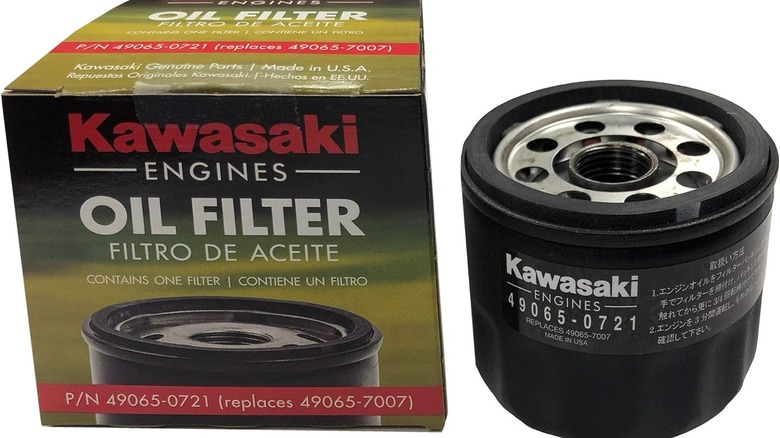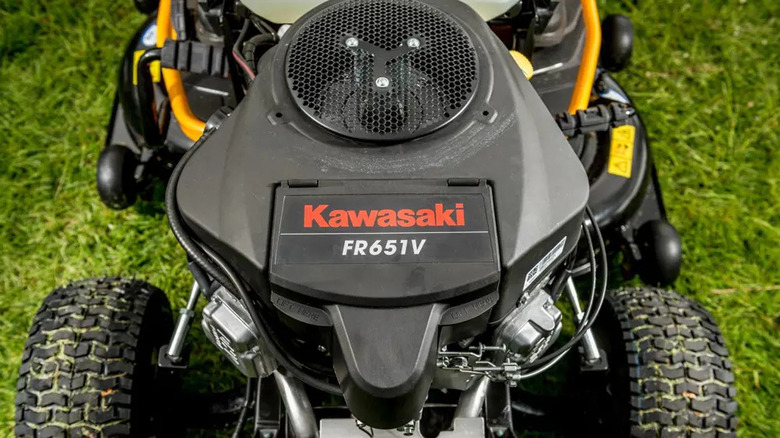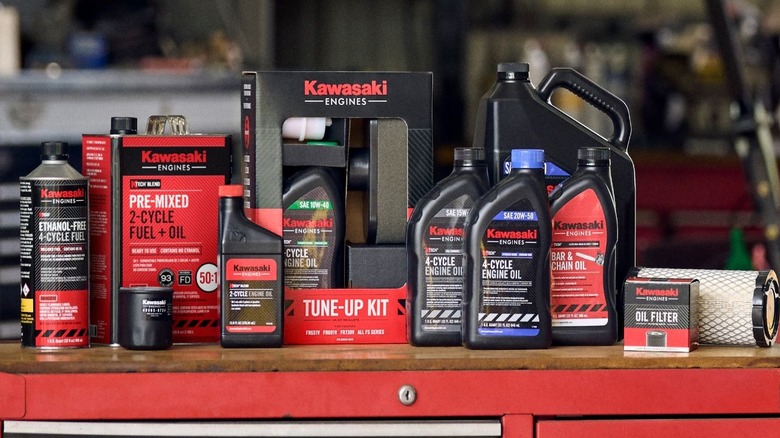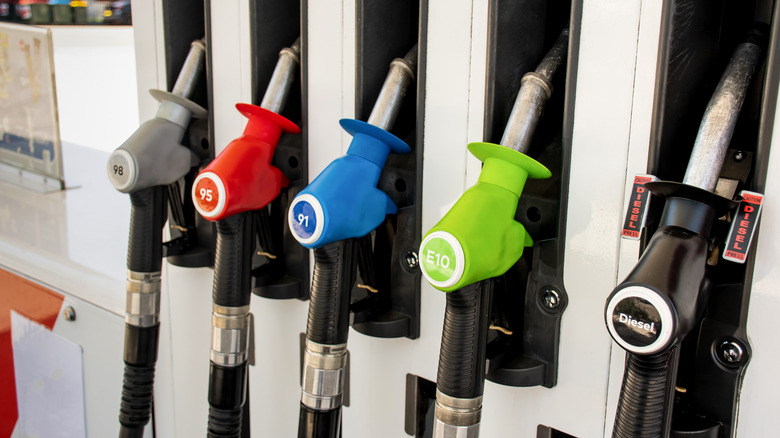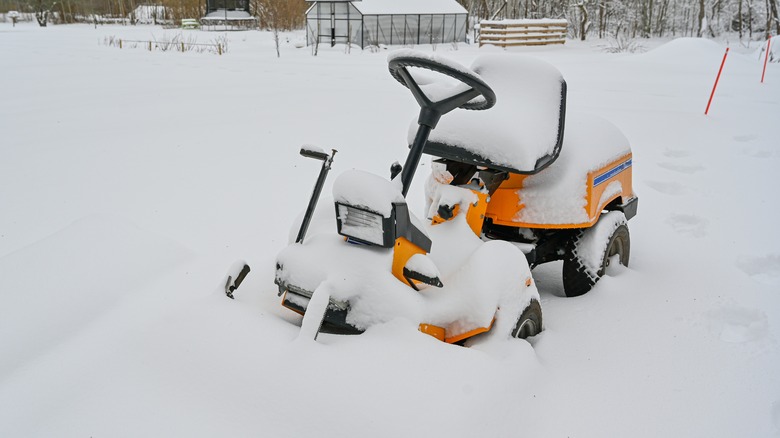5 Tips To Extend The Life Of Your Kawasaki Lawn Mower Engine
We may receive a commission on purchases made from links.
When you think of the Kawasaki brand, you probably think of high-performance, eye-catching motorcycles. That's a sensible line of thought, and indeed, motorcycles are a large part of what earned Kawasaki its pedigree. However, motorcycles aren't the only mechanical developments that Kawasaki dabbles in. It's also got a knack for creating engines, specifically those intended for personal and commercial lawn mowers.
Kawasaki manufactures a variety of engines, such as the powerful FR691V, designed to output the necessary muscle for a hard-working, lawn-munching mower. Befitting its reputation, Kawasaki builds its lawn mower engines to last, shoring them up with the latest technology and design sensibilities. However, no matter how powerful an engine is, it won't last long if you don't treat it with the care and respect that it deserves. If you want to own a lawn mower with a Kawasaki engine equipped, it's on you to take proper care of it and maximize its lifespan. This includes providing regular maintenance, using the best parts, and generally offering the best care you can.
Remember to replace the air and oil filters as necessary
The first thing you should remember when caring for your Kawasaki lawn mower engine, or any engine for that matter, is regular replacement of air and oil filters. The air filter captures dust and debris from outside of the engine and keeps it from choking up its inner workings, while the oil filter protects the engine's oil circulation system from contaminants. Both of these components have very finite operational times, usually needing to be replaced after around 200 cumulative hours of usage.
After you've put your lawn mower and its engine through the wringer, remember to swap out both of those filters with fresh ones to keep the entire system clean and fully functional. Incidentally, in addition to replacement, the paper element of an air filter in particular should be given a quick cleaning after around 100 hours of usage. You can do this by pulling it out and giving it a firm tap to knock the dust loose. If the dust refuses to come out, you may need to replace it early.
Regularly clean and service the cooling system
A lawn mower engine works extremely hard while in use, as not only does it need to power the mower's movement, but also the spinning of its blade rotors. All while the latter is constantly buffeted by debris from your lawn. To alleviate this intense workload, many Kawasaki lawn mower engines are equipped with air or liquid cooling systems. These help keep the engine temperature even so it can continue its output without overheating.
A cooling system isn't magic, though. Much like the mower and the rest of the engine, it's regularly subjected to physical punishment, and needs your help to stay in shape. Remember to give the engine's cooling system a regular inspection to check for obstructions and damage. Take a good look at the flywheel fan, cooling fins, and radiator for any signs of damage, wearing, or failure, and get them replaced right away if necessary. Even if all the parts look fine, you should also check the surface and internals of the cooling system for any debris like grass, dirt, or rocks and clean them out. Lastly, check the cooler's rotary screen before every mowing, but you can save the deep inspection for every 100 hours of use or so.
Stick to Kawasaki-branded parts and fluids
To support all the engines it creates, Kawasaki also manufactures and sells the necessary components for all of its models. You can find genuine Kawasaki parts such as air filters, oil filters, spark plugs, cooling system parts, and engine oil via authorized Kawasaki engine dealers. Any business that sells new Kawasaki engines should be able to get you the hook-up on whatever parts you need.
Of course, buying parts from a premium brand like Kawasaki will almost definitely run you more cash than buying generic parts from random automotive stores. While there's no hard and fast rule against using generic components in your Kawasaki engine, though, the brand does recommend sticking to genuine parts if you can. After all, all Kawasaki parts are manufactured by Kawasaki itself for the express use in lawn mowers, which means if something goes wrong, it'll take full responsibility. If you stick random, no-name parts in your lawn mower engine, even ones that allegedly meet the necessary specs, there's no way to tell how well they'll actually function, nor will Kawasaki offer you any kind of sympathy or support if something goes wrong.
Only use regular pump gas to power the engine
One of the nice things about a Kawasaki lawn mower engine is that you don't need any kind of special fuel or power system to make it work. Kawasaki engines are designed to receive ordinary ethanol blend gasoline as fuel, the same E-10 blend you'll find on the regular pump at your local gas station.
The important thing here is that Kawasaki engines are only designed to receive E-10 fuel. That's a blend of 90% lead-free gasoline and 10% ethanol, if you didn't know. Using any other kind of ethanol blend gasoline like E-15 or E-85 will almost definitely damage your engine, not to mention void your warranty in the process. Additionally, you should not use premium-grade fuel in your engine. While premium-grade gasoline is less likely to harm your engine than an incorrect regular ethanol blend, it won't provide any kind of tangible benefit to your engine's performance or longevity. If it's not going to do anything helpful, there's no reason to waste the extra cash on high-grade fuel.
Take extra steps to protect the engine from the winter cold
Intense cold is the mortal enemy of any engine, including those made by Kawasaki. Freezing up inhibits the engine's movement and function, and even if it doesn't lock up entirely, ambient ice can leak water into the ports and damage its internals. This is why you need to take several extra steps to protect your Kawasaki lawn mower engine in the winter time.
First, when using your lawn mower in the cold, start up the engine and let it idle for a couple of minutes before putting it to work. This gives it time to warm up and get spinning, as opposed to going whole-hog from a cold, stationary start and stressing the components.
Second, if you're storing your lawn mower regularly in below-freezing conditions, add some gas-line antifreeze to the tank to keep your fuel from freezing solid inside the engine. If you're storing gas to use in the mower later, make sure to add some fuel stabilizer for the same purpose.
Finally, when the mower, and by extension its engine, are not in use, make sure to store the whole thing in an indoor, preferably temperature-controlled environment like a house-connected garage. Do not leave your mower outdoors, or you'll expose the engine to rust and moisture damage.

